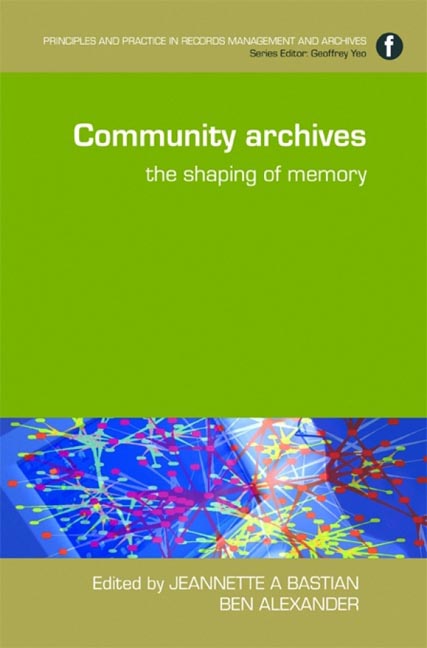Book contents
- Frontmatter
- Contents
- Introduction to the series
- Acknowledgements
- Contributors
- Introduction: Communities and archives – a symbiotic relationship
- Part 1 A community archives model
- Part 2 Communities and non-traditional record keeping
- Part 3 Records loss, destruction and recovery
- Part 4 Online communities: how technology brings communities and their records together
- 9 From Yizkor Books to weblogs: genocide, grassroots documentation and new technologies
- 10 Co-creation of the Grateful Dead sound archive: control, access and curation communities
- Part 5 Building a community archive
- Conclusion: The archivist and community
- Bibliography
- Index
- Miscellaneous Endmatter
- Miscellaneous Endmatter
- Miscellaneous Endmatter
9 - From Yizkor Books to weblogs: genocide, grassroots documentation and new technologies
from Part 4 - Online communities: how technology brings communities and their records together
Published online by Cambridge University Press: 08 June 2018
- Frontmatter
- Contents
- Introduction to the series
- Acknowledgements
- Contributors
- Introduction: Communities and archives – a symbiotic relationship
- Part 1 A community archives model
- Part 2 Communities and non-traditional record keeping
- Part 3 Records loss, destruction and recovery
- Part 4 Online communities: how technology brings communities and their records together
- 9 From Yizkor Books to weblogs: genocide, grassroots documentation and new technologies
- 10 Co-creation of the Grateful Dead sound archive: control, access and curation communities
- Part 5 Building a community archive
- Conclusion: The archivist and community
- Bibliography
- Index
- Miscellaneous Endmatter
- Miscellaneous Endmatter
- Miscellaneous Endmatter
Summary
Introduction
In the aftermath of World War 1, the journalist Aram Antonean, a survivor of the Armenian genocide of 1915–16, collected testimony from other survivors and published it, along with photographs and other documents, in a book entitled Mets ochire [The Great Crime] (Antonean, 1921). Antonean, and others, recognized the urgent necessity of capturing these stories. In the introduction to his book, he wrote: ‘Many times, I thought that a volume needs to be written for each [survivor] in order to encompass, at least in a schematic way, the overall picture of the terrible horrors. And there were a hundred thousand of these survivors, each one of whom had a story to fill a volume’ (Slyomovics, 1998, 4).
By telling their stories, these survivors added their ‘volume’ to a collective effort to defy the attempt to efface their people, the Armenians of the Ottoman Empire, from history. Of course, Antonean realized that this effort, important as it was, was destined to be incomplete. Presaging David Boder's interviews1 with survivors of the Holocaust decades later, Antonean knew that the ‘colossal endeavor would still fall short of the stories of those who had perished, taking with them more than a million volumes’ (Slyomovics, 1998, 4) Sadly, this dynamic of destruction and communal reconstruction would not end with the Armenian genocide. In fact, it was an omen of things to come. Genocide and forced exile has been the 20th century's terrible and consistent companion. But despite the staggering loss of human lives and cultural heritage, communities of survivors – bound by ethnic, religious and social relations – have found remarkable ways to collectively reconstruct and remember what was lost. And despite the unique contexts and circumstances of each genocide or persecution, the survivors’ responses are similar in substance and aim. Of course, communal commemoration of the dead and of victims of national tragedy is nothing new – its visible signs, from ancient burial grounds to national war memorials to today's high-tech memorial museums and hyperlinked online documentation centres, are all around us. But each group of survivors, each generation, reinvents the process by which their lost community is commemorated. And in doing so, survivors employ those technologies most prevalent at the time.
- Type
- Chapter
- Information
- Community ArchivesThe shaping of memory, pp. 151 - 168Publisher: FacetPrint publication year: 2009
- 2
- Cited by



